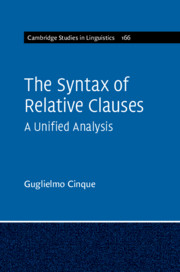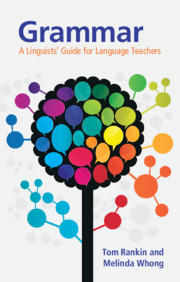Refine search
Actions for selected content:
6584 results in Grammar and Syntax
4 - The Syntax–Semantic–Pragmatic Interface of Modal Verbs
- from II - Verbal Modality
-
- Book:
- Modality in Syntax, Semantics and Pragmatics
- Published online:
- 06 February 2021
- Print publication:
- 17 September 2020, pp 107-131
-
- Chapter
- Export citation
12 - Covert Patterns of Modality
- from IV - Covert Modality
-
- Book:
- Modality in Syntax, Semantics and Pragmatics
- Published online:
- 06 February 2021
- Print publication:
- 17 September 2020, pp 333-380
-
- Chapter
- Export citation
3 - Modality as Distance: From Aspect to Modality
- from I - Modes of Modality
-
- Book:
- Modality in Syntax, Semantics and Pragmatics
- Published online:
- 06 February 2021
- Print publication:
- 17 September 2020, pp 72-104
-
- Chapter
- Export citation
IV - Covert Modality
-
- Book:
- Modality in Syntax, Semantics and Pragmatics
- Published online:
- 06 February 2021
- Print publication:
- 17 September 2020, pp 331-380
-
- Chapter
- Export citation
I - Modes of Modality
-
- Book:
- Modality in Syntax, Semantics and Pragmatics
- Published online:
- 06 February 2021
- Print publication:
- 17 September 2020, pp 11-104
-
- Chapter
- Export citation
III - Adverbial Modality
-
- Book:
- Modality in Syntax, Semantics and Pragmatics
- Published online:
- 06 February 2021
- Print publication:
- 17 September 2020, pp 211-330
-
- Chapter
- Export citation
Bibliography
-
- Book:
- Modality in Syntax, Semantics and Pragmatics
- Published online:
- 06 February 2021
- Print publication:
- 17 September 2020, pp 381-415
-
- Chapter
- Export citation
11 - Modal Particles outside of Finiteness
- from III - Adverbial Modality
-
- Book:
- Modality in Syntax, Semantics and Pragmatics
- Published online:
- 06 February 2021
- Print publication:
- 17 September 2020, pp 311-330
-
- Chapter
- Export citation
Acknowledgments
-
- Book:
- Modality in Syntax, Semantics and Pragmatics
- Published online:
- 06 February 2021
- Print publication:
- 17 September 2020, pp xxiv-xxiv
-
- Chapter
- Export citation
8 - Modal Particles: The Enigmatic Category
- from III - Adverbial Modality
-
- Book:
- Modality in Syntax, Semantics and Pragmatics
- Published online:
- 06 February 2021
- Print publication:
- 17 September 2020, pp 213-237
-
- Chapter
- Export citation
Preface
-
- Book:
- Modality in Syntax, Semantics and Pragmatics
- Published online:
- 06 February 2021
- Print publication:
- 17 September 2020, pp xxi-xxiii
-
- Chapter
- Export citation
1 - Pragmatics: Modality and Speaker Orientation
- from I - Modes of Modality
-
- Book:
- Modality in Syntax, Semantics and Pragmatics
- Published online:
- 06 February 2021
- Print publication:
- 17 September 2020, pp 13-59
-
- Chapter
- Export citation
9 - The Attitudinal Force of Modal Particles
- from III - Adverbial Modality
-
- Book:
- Modality in Syntax, Semantics and Pragmatics
- Published online:
- 06 February 2021
- Print publication:
- 17 September 2020, pp 238-289
-
- Chapter
- Export citation
Introduction
-
- Book:
- Modality in Syntax, Semantics and Pragmatics
- Published online:
- 06 February 2021
- Print publication:
- 17 September 2020, pp 1-10
-
- Chapter
- Export citation
Contents
-
- Book:
- Modality in Syntax, Semantics and Pragmatics
- Published online:
- 06 February 2021
- Print publication:
- 17 September 2020, pp ix-xvi
-
- Chapter
- Export citation
II - Verbal Modality
-
- Book:
- Modality in Syntax, Semantics and Pragmatics
- Published online:
- 06 February 2021
- Print publication:
- 17 September 2020, pp 105-210
-
- Chapter
- Export citation
6 - The Syntax of Modal Verbs in German, Dutch, and English
- from II - Verbal Modality
-
- Book:
- Modality in Syntax, Semantics and Pragmatics
- Published online:
- 06 February 2021
- Print publication:
- 17 September 2020, pp 157-187
-
- Chapter
- Export citation
Index
-
- Book:
- Modality in Syntax, Semantics and Pragmatics
- Published online:
- 06 February 2021
- Print publication:
- 17 September 2020, pp 416-424
-
- Chapter
- Export citation

The Syntax of Relative Clauses
- A Unified Analysis
-
- Published online:
- 10 September 2020
- Print publication:
- 24 September 2020

Grammar
- A Linguists' Guide for Language Teachers
-
- Published online:
- 10 September 2020
- Print publication:
- 01 October 2020
